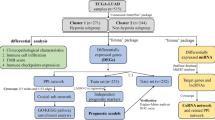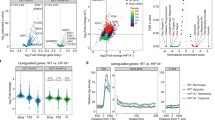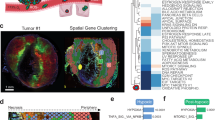Abstract
Recent data have linked hypoxia, a classic feature of the tumor microenvironment, to the function of specific microRNAs (miRNAs); however, whether hypoxia affects other types of noncoding transcripts is currently unknown. Starting from a genome-wide expression profiling, we demonstrate for the first time a functional link between oxygen deprivation and the modulation of long noncoding transcripts from ultraconserved regions, termed transcribed-ultraconserved regions (T-UCRs). Interestingly, several hypoxia-upregulated T-UCRs, henceforth named ‘hypoxia-induced noncoding ultraconserved transcripts’ (HINCUTs), are also overexpressed in clinical samples from colon cancer patients. We show that these T-UCRs are predominantly nuclear and that the hypoxia-inducible factor (HIF) is at least partly responsible for the induction of several members of this group. One specific HINCUT, uc.475 (or HINCUT-1) is part of a retained intron of the host protein-coding gene, O-linked N-acetylglucosamine transferase, which is overexpressed in epithelial cancer types. Consistent with the hypothesis that T-UCRs have important function in tumor formation, HINCUT-1 supports cell proliferation specifically under hypoxic conditions and may be critical for optimal O-GlcNAcylation of proteins when oxygen tension is limiting. Our data gives a first glimpse of a novel functional hypoxic network comprising protein-coding transcripts and noncoding RNAs (ncRNAs) from the T-UCRs category.
Similar content being viewed by others
Log in or create a free account to read this content
Gain free access to this article, as well as selected content from this journal and more on nature.com
or
Accession codes
Abbreviations
- miRNA:
-
microRNA
- ncRNA:
-
noncoding RNA
- T-UCR:
-
transcribed-ultraconserved gene
- PCR:
-
polymerase chain reaction
- RT-qPCR:
-
quantitative reverse transcription PCR
- DMOG:
-
dimethyloxalylglycine
- DMSO:
-
dimethyl sulfoxide
- CA9:
-
carbonic anhydrase IX
- HIF:
-
hypoxia-inducible factor
- CRC:
-
colorectal carcinoma
- Cq:
-
quantification cycle
- OGT:
-
O-linked N-acetylglucosamine (GlcNAc) transferase
- HINCUTs:
-
hypoxia-induced noncoding ultraconserved transcripts
- VHL:
-
Von Hippel–Lindau tumor suppressor
- WT:
-
wild type
- FACS:
-
fluorescence activated cell sorting
References
Harris AL . Hypoxia--a key regulatory factor in tumour growth. Nat Rev Cancer 2002; 2: 38–47.
Kulshreshtha R, Ferracin M, Wojcik SE, Garzon R, Alder H, Agosto-Perez FJ et al. A microRNA signature of hypoxia. Mol Cell Biol 2007; 27: 1859–1867.
Chan SY, Zhang YY, Hemann C, Mahoney CE, Zweier JL, Loscalzo J . MicroRNA-210 controls mitochondrial metabolism during hypoxia by repressing the iron-sulfur cluster assembly proteins ISCU1/2. Cell Metab 2009; 10: 273–284.
Favaro E, Ramachandran A, McCormick R, Gee H, Blancher C, Crosby M et al. MicroRNA-210 regulates mitochondrial free radical response to hypoxia and krebs cycle in cancer cells by targeting iron sulfur cluster protein ISCU. PloS One 2010; 5: e10345.
Devlin C, Greco S, Martelli F, Ivan M . miR-210: more than a silent player in hypoxia. IUBMB Life 2011; 63: 94–100.
Huang X, Le QT, Giaccia AJ . MiR-210--micromanager of the hypoxia pathway. Trends Mol Med 2010; 16: 230–237.
Mattick JS . The genetic signatures of noncoding RNAs. PLoS Genet 2009; 5: e1000459.
Calin G, Liu C, Ferracin M, Hyslop T, Spizzo R, Sevignani C et al. Ultraconserved regions encoding ncRNAs are altered in human leukemias and carcinomas. Cancer Cell 2007; 12: 215–229.
Bejerano G, Pheasant M, Makunin I, Stephen S, Kent WJ, Mattick JS et al. Ultraconserved elements in the human genome. Science 2004; 304: 1321–1325.
Bejerano G, Haussler D, Blanchette M . Into the heart of darkness: large-scale clustering of human non-coding DNA. Bioinformatics 2004; 20 (Suppl 1): i40–i48.
Braconi C, Valeri N, Kogure T, Gasparini P, Huang N, Nuovo GJ et al. Expression and functional role of a transcribed noncoding RNA with an ultraconserved element in hepatocellular carcinoma. Proc Natl Acad Sci USA 2011; 108: 786–791.
Scaruffi P, Stigliani S, Coco S, Valdora F, De Vecchi C, Bonassi S et al. Transcribed-ultra conserved region expression profiling from low-input total RNA. BMC Genomics 2010; 11: 149.
Mestdagh P, Fredlund E, Pattyn F, Rihani A, Van Maerken T, Vermeulen J et al. An integrative genomics screen uncovers ncRNA T-UCR functions in neuroblastoma tumours. Oncogene 2010; 29: 3583–3592.
Bejerano G, Lowe CB, Ahituv N, King B, Siepel A, Salama SR et al. A distal enhancer and an ultraconserved exon are derived from a novel retroposon. Nature 2006; 441: 87–90.
Pennacchio LA, Ahituv N, Moses AM, Prabhakar S, Nobrega MA, Shoukry M et al. In vivo enhancer analysis of human conserved non-coding sequences. Nature 2006; 444: 499–502.
Xu J, Wang B, Xu Y, Sun L, Tian W, Shukla D et al. Epigenetic regulation of HIF-1alpha in renal cancer cells involves HIF-1alpha/2alpha binding to a reverse hypoxia-response element. Oncogene 2012; 31: 1065–1072.
Kent WJ, Sugnet CW, Furey TS, Roskin KM, Pringle TH, Zahler AM et al. The human genome browser at UCSC. Genome Res 2002; 12: 996–1006.
Ivan M, Kondo K, Yang H, Kim W, Valiando J, Ohh M et al. HIFalpha targeted for VHL-mediated destruction by proline hydroxylation: implications for O2 sensing. Science 2001; 292: 464–468.
Nolte D, Muller U . Human O-GlcNAc transferase (OGT): genomic structure, analysis of splice variants, fine mapping in Xq13.1. Mamm Genome 2002; 13: 62–64.
Kreppel LK, Blomberg MA, Hart GW . Dynamic glycosylation of nuclear and cytosolic proteins. Cloning and characterization of a unique O-GlcNAc transferase with multiple tetratricopeptide repeats. J Biol Chem 1997; 272: 9308–9315.
Lubas WA, Frank DW, Krause M, Hanover JA . O-Linked GlcNAc transferase is a conserved nucleocytoplasmic protein containing tetratricopeptide repeats. J Biol Chem 1997; 272: 9316–9324.
Caldwell SA, Jackson SR, Shahriari KS, Lynch TP, Sethi G, Walker S et al. Nutrient sensor O-GlcNAc transferase regulates breast cancer tumorigenesis through targeting of the oncogenic transcription factor FoxM1. Oncogene 2010; 29: 2831–2842.
Mi W, Gu Y, Han C, Liu H, Fan Q, Zhang X et al. O-GlcNAcylation is a novel regulator of lung and colon cancer malignancy. Biochim Biophys Acta 2011; 1812: 514–519.
Lynch TP, Ferrer CM, Jackson SR, Shahriari KS, Vosseller K, Reginato MJ . Critical role of O-GlcNAc transferase in prostate cancer invasion, angiogenesis and metastasis. J Biol Chem 2012; 287: 11070–11081.
Taylor RP, Parker GJ, Hazel MW, Soesanto Y, Fuller W, Yazzie MJ et al. Glucose deprivation stimulates O-GlcNAc modification of proteins through up-regulation of O-linked N-acetylglucosaminyltransferase. J Biol Chem 2008; 283: 6050–6057.
Robinson KA, Weinstein ML, Lindenmayer GE, Buse MG . Effects of diabetes and hyperglycemia on the hexosamine synthesis pathway in rat muscle and liver. Diabetes 1995; 44: 1438–1446.
Butkinaree C, Park K, Hart GW . O-linked beta-N-acetylglucosamine (O-GlcNAc): extensive crosstalk with phosphorylation to regulate signaling and transcription in response to nutrients and stress. Biochim Biophys Acta 2010; 1800: 96–106.
Dong DL, Hart GW . Purification and characterization of an O-GlcNAc selective N-acetyl-beta-D-glucosaminidase from rat spleen cytosol. J Biol Chem 1994; 269: 19321–19330.
Visel A, Prabhakar S, Akiyama JA, Shoukry M, Lewis KD, Holt A et al. Ultraconservation identifies a small subset of extremely constrained developmental enhancers. Nat Genet 2008; 40: 158–160.
Orom UA, Derrien T, Beringer M, Gumireddy K, Gardini A, Bussotti G et al. Long noncoding RNAs with enhancer-like function in human cells. Cell 2010; 143: 46–58.
Ozsolak F, Poling LL, Wang Z, Liu H, Liu XS, Roeder RG et al. Chromatin structure analyses identify miRNA promoters. Genes Develop 2008; 22: 3172–3183.
Love DC, Ghosh S, Mondoux MA, Fukushige T, Wang P, Wilson MA et al. Dynamic O-GlcNAc cycling at promoters of Caenorhabditis elegans genes regulating longevity, stress, and immunity. Proc Natl Acad Sci USA 2010; 107: 7413–7418.
Nott A, Meislin SH, Moore MJ . A quantitative analysis of intron effects on mammalian gene expression. RNA 2003; 9: 607–617.
Ryu WS, Mertz JE . Simian virus 40 late transcripts lacking excisable intervening sequences are defective in both stability in the nucleus and transport to the cytoplasm. J Virol 1989; 63: 4386–4394.
Chang CY, Hong WW, Chong P, Wu SC . Influence of intron and exon splicing enhancers on mammalian cell expression of a truncated spike protein of SARS-CoV and its implication for subunit vaccine development. Vaccine 2006; 24: 1132–1141.
Zhao C, Hamilton T . Introns regulate the rate of unstable mRNA decay. J Biol Chem 2007; 282: 20230–20237.
Wang HF, Feng L, Niu DK . Relationship between mRNA stability and intron presence. Biochem Biophys Res Commun 2007; 354: 203–208.
Gencheva M, Lin TY, Wu X, Yang L, Richard C, Jones M et al. Nuclear retention of unspliced pre-mRNAs by mutant DHX16/hPRP2, a spliceosomal DEAH-box protein. J Biol Chem 2010; 285: 35624–35632.
Gardner LB . Hypoxic inhibition of nonsense-mediated RNA decay regulates gene expression and the integrated stress response. Mol Cell Biol 2008; 28: 3729–3741.
Buchman AR, Berg P . Comparison of intron-dependent and intron-independent gene expression. Mol Cell Biol 1988; 8: 4395–4405.
Le Hir H, Nott A, Moore MJ . How introns influence and enhance eukaryotic gene expression. Trends Biochem Sci 2003; 28: 215–220.
Kibel A, Iliopoulos O, DeCaprio JA, Kaelin WG Jr . Binding of the von Hippel-Lindau tumor suppressor protein to Elongin B and C. Science 1995; 269: 1444–1446.
Romano P, Manniello A, Aresu O, Armento M, Cesaro M, Parodi B . Cell Line Data Base: structure and recent improvements towards molecular authentication of human cell lines. Nucleic Acids Res 2009; 37 Database issue D925–D932.
Safdar A, Abadi A, Akhtar M, Hettinga BP, Tarnopolsky MA . miRNA in the regulation of skeletal muscle adaptation to acute endurance exercise in C57Bl/6J male mice. PLoS One 2009; 4: e5610.
Livak KJ, Schmittgen TD . Analysis of relative gene expression data using real-time quantitative PCR and the 2(-Delta Delta C(T)) Method. Methods 2001; 25: 402–408.
Matys V, Fricke E, Geffers R, Gossling E, Haubrock M, Hehl R et al. TRANSFAC: transcriptional regulation, from patterns to profiles. Nucleic Acids Res 2003; 31: 374–378.
Gao Y, Wells L, Comer FI, Parker GJ, Hart GW . Dynamic O-glycosylation of nuclear and cytosolic proteins: cloning and characterization of a neutral, cytosolic beta-N-acetylglucosaminidase from human brain. J Biol Chem 2001; 276: 9838–9845.
Liu CG, Calin GA, Meloon B, Gamliel N, Sevignani C, Ferracin M et al. An oligonucleotide microchip for genome-wide microRNA profiling in human and mouse tissues. Proc Natl Acad Sci USA 2004; 101: 9740–9744.
Acknowledgements
Dr. Calin is The Alan M. Gewirtz Leukemia and Lymphoma Society Scholar. He is supported also as a Fellow at The University of Texas, MD Anderson Research Trust, as a University of Texas System Regents Research Scholar and by the CLL Global Research Foundation. Work in Dr. Calin’s laboratory is supported in part by the NIH/NCI (CA135444), a Department of Defense Breast Cancer Idea Award, Developmental Research Awards in Breast Cancer, Ovarian Cancer, Brain Cancer, Prostate Cancer, Multiple Myeloma, Leukemia (P50 CA100632) and Head and Neck (P50 CA097007) SPOREs, a SINF MDACC_DKFZ grant in CLL, the Laura and John Arnold Foundation, the RGK Foundation and the Estate of CG Johnson, Jr. Dr. Ling is an Odyssey Fellow, and his work is supported in part by the Odyssey Program and The Estate of CG Johnson, JR at The University of Texas, MD Anderson Cancer Center. Additional support for the research was provided by the Slovenian Research Agency (ARRS) through the Research program P4-0220 to TK and project 30767 to JF. Dr. Ivan is an American Cancer Society Research Scholar (RSG-09-244-01-TBG). Work in Dr. Ivan’s laboratory is also supported by the NIH/NCI (R01 CA155332-01A1). We thank Mei Koh for assistance with the hypoxia experiments. We thank Ashley R. Heath (Sigma-Aldrich, Woodlands, TX, USA) for the siRNA design. STR DNA fingerprinting was performed by the Cancer Center Support grant-funded Characterized Cell Line core, NCI no. CA16672. We thank Ann Sutton (Department of Scientific Publications, MD Anderson Cancer Center) for her help with the editing of this manuscript.
Author information
Authors and Affiliations
Corresponding authors
Ethics declarations
Competing interests
The authors declare no conflict of interest.
Additional information
Edited by G Melino
Authors Contributions
Study concept and design: Calin, Ivan and Kunej; development of methodology: Calin, Ivan, Kunej and Davuluri; acquisition of data: Ferdin, Wu, Nishida, Nicoloso, Shah, Devlin, Ling, Shimizu, Kumar, Cortez and Schmittgen; analysis and interpretation of data: Ferdin, Nishida, Voorhoeve, Reginato, Negrini, Davuluri, Kunej, Ivan and Calin; statistical analysis: Ferracin, Bi, Yang, Czerniak, Zhang and Davuluri; administrative, technical or material support: Shimizu, Schmittgen and Reginato; drafting of the manuscript: Ferdin, Nishida, Kunej, Ivan and Calin. All authors critically reviewed the manuscript and approved the final version.
Supplementary Information accompanies this paper on Cell Death and Differentiation website
Supplementary information
Rights and permissions
About this article
Cite this article
Ferdin, J., Nishida, N., Wu, X. et al. HINCUTs in cancer: hypoxia-induced noncoding ultraconserved transcripts. Cell Death Differ 20, 1675–1687 (2013). https://doi.org/10.1038/cdd.2013.119
Received:
Revised:
Accepted:
Published:
Issue date:
DOI: https://doi.org/10.1038/cdd.2013.119
Keywords
This article is cited by
-
Non-coding RNAs regulation of macrophage polarization in cancer
Molecular Cancer (2021)
-
Signaling in and out: long-noncoding RNAs in tumor hypoxia
Journal of Biomedical Science (2020)
-
Uc.63+ contributes to gastric cancer progression through regulation of NF-kB signaling
Gastric Cancer (2020)
-
The long non-coding RNA uc.4 influences cell differentiation through the TGF-beta signaling pathway
Experimental & Molecular Medicine (2018)
-
The lncRNA HOTAIRM1 regulates the degradation of PML-RARA oncoprotein and myeloid cell differentiation by enhancing the autophagy pathway
Cell Death & Differentiation (2017)



